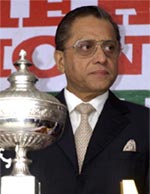The performance of the Indian cricket team in Test series played abroad continues to make its fans reach out for antacids. To the average cricket fan, it is incomprehensible how a team that can play so well at home can flounder so badly when it steps foot on foreign soil. Many reasons have been quoted for our debacles -- bad batting techniques inculcated from years of playing on dead surfaces, lack of mental grit and determination, lack of bowling depth, etc.
However, we often tend to take a narrow view of the problem when trying to analyze it. It is often the most convenient explanation. However, I would like to present a case that cricket like all other world sports today, is a business, and in India, it is not being run and managed as one. This is the biggest problem that faces the sport in India today. Once I have laid out the similarities of sports and successful businesses, I will juxtapose this view with the Indian cricket scene and articulate what all this means to ardent and frustrated fans like me.
In the last ten years, sports has turned out to be one of the fastest growing industries in the world. Many sports and franchises have recognized this and successfully tapped into this opportunity. The key driver behind this phenomenon is the captive audience that the sport presents to media companies who are looking to broaden their coverage to give them increased advertising revenue potential.
Like any other business, in order to successfully tap into a business opportunity, a few fundamental things need to be in place:
- An emphasis on putting out an attractive product for your consumers. In case of sports, this is achieved by creating intense competition in the sport and development of successful franchises that capture the imagination of sports fans.
- Careful planning around the grass root development of sports with a 10 to 20 year vision in mind that can facilitate the spawning of talent. After all, it is the Jordans, the Woods, the Tendulkars and the Schumachers that make everyone want to be associated with their sport.
- Constantly think about the growth of the revenue base. In most sports today, the revenues from gate collections of the events are only one component of the overall pie. Increasingly the larger revenues come from the media rights and the sponsorship opportunities for the large brands. Hence, it is important to think ahead and work towards creating compelling value propositions for these constituents to want to spend more to be associated with your sport. And that boils down to the attractiveness of the sport to the fans and viewers of your sport.
- Finally, you need to have a management team that understands all these priorities, has the experience in running large businesses and have a proven track record of being accountable to their stakeholders.
However, unlike some of the other industries, the business of sports has some unique characteristics. For one, the management team is not accountable solely to shareholders, but to the fans and viewers of the sport. It is similar to the entertainment and arts industry where the main product is the song, album, film or artist and the industry primary objective is to whet the appetite of the patrons of the art form. Thus the emphasis should always be on serving the fans and viewers and the sponsorships/media rights will follow.
In order to get evidence of this phenomenon, one just needs to take a look at the NFL in the US, the rapid emergence of Golf as a global sport and the continued dominance of Soccer as a most popular sport in the world. In a smaller sense, the emergence of Australian cricket can also be attributed to this thinking. Yes, it is true that the fans are what make the sport, but with the proliferation of various media like TV and the Internet, fans, sponsors and media companies have choices and they will abandon your sport if you do not put out a competitive and high quality product in the market. An example of a sport that went south in recent years is US baseball (the national past time of the country). You are competing with other sports for the attention of fans and viewers, but also with other forms of entertainment.
Now let's look at the game of cricket in general and Indian cricket in particular and assess how it stacks up as a successful business. Firstly, let's understand that the administrators of the sport at a global and individual franchise (read country) level have no choice but to take this view. The reason for this is that they are competing with other sports for attention and they have to remain competitive. Having understood this, it is a reasonable observation that the sport has progressed tremendously in the last ten years or so in terms of the packaging, the level of competition and the brand of cricket that is being played.
The ICC has done a fair job of negotiating huge media and sponsorship contracts for some of the major events (the player contract crisis being the only aberration). Some of the boards like the Australian Cricket Board have made concerted efforts to capitalize on this trend. They are doing this by creating a solid infrastructure to produce a world-class and exciting product, which will attract fans and sponsors. There are other innovations like Super Max cricket looming on the horizon to make the sport more appealing for broader TV audiences. There are still a number of challenges that need to be addressed to make cricket a global sport -- the waning popularity of Test cricket, the limited number of countries that play serious cricket and the need for a more meaningful and relevant cricket schedule are some of them.
 Indian cricket is administered by the BCCI, which is a quasi government organization that is run by bureaucrats and administrators. India has the largest cricket fan base around the world. Thus, one of the vital ingredients for the business of cricket is in place. The Indian team's performance has been fairly decent in recent years too. However, Indian cricket is a badly managed business venture. Here are some indicators that point to this fact:
Indian cricket is administered by the BCCI, which is a quasi government organization that is run by bureaucrats and administrators. India has the largest cricket fan base around the world. Thus, one of the vital ingredients for the business of cricket is in place. The Indian team's performance has been fairly decent in recent years too. However, Indian cricket is a badly managed business venture. Here are some indicators that point to this fact:
- No emphasis on investing in the infrastructure of the sport, which includes stadiums, training facilities, school and university level infrastructure, technology, cricket academies etc.
- No investment in grooming talent which is illustrated by the state of the national tournaments. How many of us can recall the finalists of last year's Ranji Trophy? The current system is geared to churn out players who will not succeed in international playing conditions.
- A fatalistic and individualistic attitude amongst our players and administrators that prevents them from pondering over our deficiencies on the field and constantly seek improvement.
- Financial incentives for players are lopsided and not linked to performance. The gap between the cricketers playing at a domestic level and the international level is too huge to make it possible for talent to sustain itself.
- Our dismal overseas Test record has been attributed to our players' inability to cope with alien conditions. Yet, there is no attempt made to introduce some of the modern techniques, technologies, amenities and playing conditions at the domestic level so that we can churn out new cricketers who are tuned in to international playing conditions.
- A non-professional management that is elected through a private election process and consists of bureaucrats who are neither professional business managers not seasoned cricketers. They are accountable to no one -- neither the media nor the fans nor any governing body.
In spite of all these indicators, the Indian board is the richest in the world. However, this is an outcome of the craze associated with the sport. This has resulted in the board landing fat media rights and sponsorship contracts without even breaking a sweat. This windfall brings along the kind of arrogance and myopic view that we have to come to associate our board with. This accounts for the Mr. Lele, who admonishes reporters for asking him why the Indian team does not have access to the latest software technology to improve their game or Mr. Dalmiya who does not even bother to go or send a representative to meet our team who is trying to get their interests protected on the contract issue while playing a tough series in England.
At the end of the day, our board does not give two hoots about putting out the best product out there for public consumption. All their actions and decisions point to this conclusion. Like a totalitarian state or a monopoly, they believe that no matter what they put out there the money will keep flowing in. So why bother?
This kind of disregard and apathy is similar to the one displayed by the Indian Hockey Federation in the eighties when Indian hockey was challenged by a new brand of the sport introduced by the Europeans. We staunchly resisted all the changes -- labeled them as upstarts and reveled in our past glory. The result -- the demise of Indian hockey. At least, the IHF can argue that they did not have the financial resources at the time to catch up with the Europeans. But the BCCI has no such excuse. They have all the money in the world. The question really is what are they doing with this wealth. What makes it even more puzzling is that it is the Indian fan and viewer base that has enabled the ICC to negotiate these lucrative media and sponsorship deals. Countries like Australia and South Africa who see the potential of the sport have already made efforts to capitalize on this financial windfall and they are using it as a platform to grow it even further. And ironically, the Indian board is content with maintaining status quo. Any self-respecting business manager will tell you that maintaining status quo is the beginning of the end of your business.
This abject mismanagement will catch up with the sport in the worst possible manner. We will continue to have flashes of brilliance at an international level but fail to succeed at the highest level. Fans will eventually be disillusioned, the media rights will lose the premium that it now commands and the sponsors will desert the sport. We will go on to bask in the glory of our past achievements. Our administrators will find someone to blame -- the media or the non-Asian countries that are "jealous" of our "success" or the fickle fans that have "unreasonable expectations". New playing formats like the Super Max will be introduced. New technological advancements will come along. The game will be geared completely towards television. And we would have been a sorry story of a nation who had a great opportunity but did not capitalize on its initial success to go on and create a dynasty. The world of business is littered with the carcasses of companies who had this fate handed to them because of a lack of foresight and vision.
 What does this mean to us fans? All that we ask for is that our sport be managed effectively, that we have our board share its strategic vision and for them to put out a team that performs consistently at the highest levels of the sport. We cannot go on being oblivious of the changes that are happening within the sport at a global level. We cannot continue to give the board a pass for their lack of vision. We are the principal stakeholders that are contributing to the coffers of the board. We cannot continue to believe that this is the simple sport that it was till the eighties. We have to stop this obsession of worshipping and criticizing individual cricketers. It is a sport that is trying to compete with other sports for air time and eyeballs. It is a sport that will morph itself into more radical formats geared to serve its true masters – fans and viewers. It will be a battle between teams from countries that can compete at various levels – skills, technology and physical abilities.
What does this mean to us fans? All that we ask for is that our sport be managed effectively, that we have our board share its strategic vision and for them to put out a team that performs consistently at the highest levels of the sport. We cannot go on being oblivious of the changes that are happening within the sport at a global level. We cannot continue to give the board a pass for their lack of vision. We are the principal stakeholders that are contributing to the coffers of the board. We cannot continue to believe that this is the simple sport that it was till the eighties. We have to stop this obsession of worshipping and criticizing individual cricketers. It is a sport that is trying to compete with other sports for air time and eyeballs. It is a sport that will morph itself into more radical formats geared to serve its true masters – fans and viewers. It will be a battle between teams from countries that can compete at various levels – skills, technology and physical abilities.
So is there a silver lining? It is not all gloom and doom for India. India currently has the financial resources to beat the living daylights out of all the countries in this race. India contributes to more than 60 per cent of the revenues of the sport. The largest sponsors of the sport in the world are Indian corporations. We always produced great cricketing talent. We can take all these assets at our disposal and turn the sport on its head. But this opportunity is not going to translate itself into supremacy in the sport unless some fundamental changes happen.
- A complete change in the way the sport is managed. We need someone who can crack the whip and take over as the Commissioner of the sport. It is a title borrowed from some of the US sports. Ideally this person should be somebody like a Seshan or a Khairnar (these names are meant to illustrate the kind of personalities needed and not as candidates for the job), who has no vested interests and have a track record of single mindedly pursuing a goal. Surround this person with successful and professional business managers from various industries. This will instill a new sense of accountability.
- The new management needs to lay out a three, five and ten-year strategic plan and clearly articulate its goals and objectives over these periods. Unlike other plans published in India, these plans should have mechanisms in place to be reviewed annually.
- This plan needs to cover among other things, the proposed upgrade to the entire infrastructure associated with the sport. This plan needs to put various mechanisms in place to cultivate and nurture talent at a grass root level.
- The blooding in of the new management should breed a new culture of accountability from the selectors and our players. A performance based recognition and incentive system should be introduced and ruthlessly implemented.
- We should stop whining that the non-Asians are taking over the sport and contribute meaningfully to the development of the sport at a global level. We need to take a lead in this effort.
- This new-look Board of Control for Cricket in India should have an open communications policy in place and be mandated to have transparency with the media. This transparency is one of many hallmarks of professional sports in the United States and is one of the checks and balances in place to keep the management and administrators honest.
I am not a disillusioned Indian cricket fan (not yet). I am optimistic about the potential but skeptical about the momentum that is necessary to institute these wide-spread changes. So how do we achieve this? We, the fans of cricket, should rally against the current management of the sport in India. It's amazing what a lot of pressure from the masses can achieve? We need to get the media, former and current players and some of the captains of the Indian industry on our side. I am convinced that once we make some inroads into the morass that we call the BCCI, there will be enough seasoned and qualified candidates to take over the reins of the business of cricket.
Maybe, all this is wishful thinking. But one thing is certain -- over the next ten years or so, cricket will go through a major revolution, and whether we will continue to be as passionate about this sport as fans is squarely in the hands of those who manage the business of Indian cricket.
God bless Indian cricket.
Mail Rajan Nair